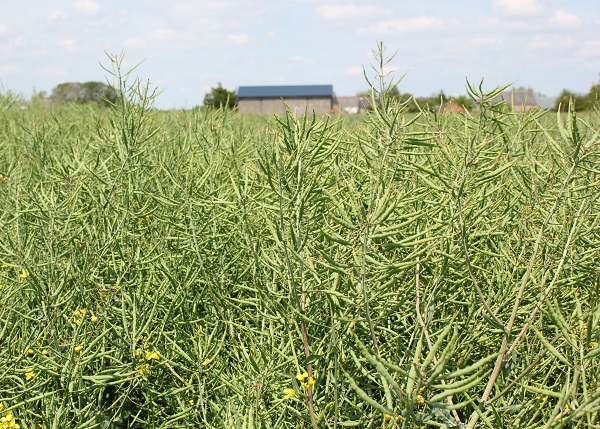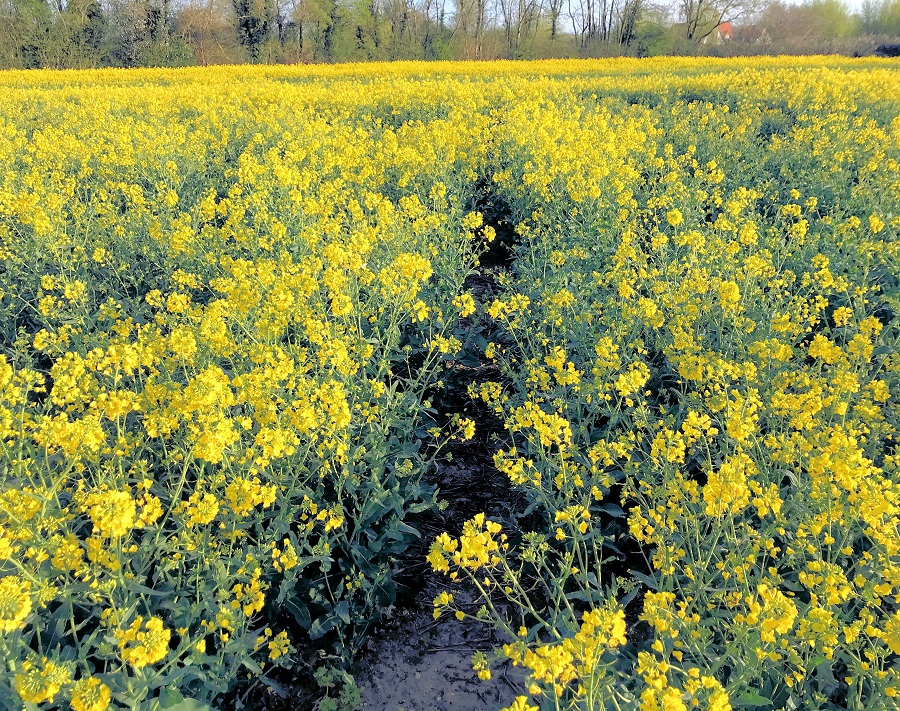While OSR crops across the country struggle in the battle against CSFB, Dekalb has been focusing on breeding even more resilience into its varieties to give growers the best chance against the yield-robbing pest. CPM reviews DK Exstar.
DK Exstar combines high yields and oil content with the best agronomy package ever seen in a Dekalb OSR variety.
By Charlotte Cunningham
Oilseed rape – arguably the marmite of the arable world at the moment. While some growers have given up all hopes of growing the crop again on the back of cabbage stem flea beetle pressures, others have persevered.
Though a solution is yet to be found, breeders – and growers alike – are perhaps unsurprisingly searching for the more robust, resilient varieties that can perform better in the face of adversity.
Among these, Bayer is claiming a place for its latest hybrid winter OSR offering from the Dekalb range – DK Exstar.

DK Exstar gleans a score of 8 for stem stiffness, phoma resistance and light leaf spot – based on data taken from the 2018/19 Candidate List.
Despite not appearing on the 2020/21 Recommended List, DK Exstar packs a pretty impressive punch, according to breeder Matthew Clarke. Gleaning a score of 8 for stem stiffness, phoma resistance and light leaf spot (based on data from the AHDB 2018/19 Candidate List) the variety has been crowned “the triple eight breakthrough’ by Dekalb.
“When breeding Exstar, we were really looking to create something that had good stem characteristics, along with the standard Dekalb traits of double phoma and pod shatter resistance,” explains Matthew. “The combination of the RLM7 gene and polygenic resistance provides durable protection against phoma stem canker, while the pod shatter resistance – which we pioneered – minimises yield loss and volunteer issues caused by seed-shedding up to, and during, harvest.”
In recent years LLS has been seen to be increasingly damaging in all areas of the UK, but strong varietal resistance allied to chemical control gives growers a high level of confidence in dealing with this threat, he adds. “Looking to the parentage of DK Exstar, we ensured that one of the parents would bring in this resistance at the highest level. As a result, the variety benefits from solid polygenic resistance, providing the best-ever level of protection from this increasingly important OSR disease.”
Another trait drawn from its parentage is lodging resistance, with DK Exstar gaining top marks in trials with a score of 9.
But these high agronomic values aren’t to the detriment of the performance of the crop, adds Matthew. “One of the most interesting and attractive things about this variety is that the package of traits doesn’t compromise yield or oil content, with official AHDB 2018/19 candidate data showing a UK yield of 105% and an oil content of 45.3%.
“In my opinion, DK Exstar combines high yields and oil content with the best agronomy package ever seen in a Dekalb OSR variety.”
Looking to DK Exstar’s in-field performance, it’s a fast-developing type which could help growers facing strong pest pressures, adds Matthew “There’s a lot of testing being done on how well material establishes, even under pest pressures. Looking to the development material and products that have a clear advantage, fast-developing types seem to come out on top.”
This rapid autumn development was a standout trait in both breeding trials and commercial trials, explains Richard Phillips, Bayer’s market development manager for Dekalb varieties. “In the breeding trials last year and our own commercial trials this year, DK Exstar has consistently been very good. It’s suitable for a wide range of situations as it’s a rapid-growing variety, but it’s also very strong so growers don’t need to be concerned about lodging.”
So much so, that in trial sites last year where lodging did occur, DK Exstar was still standing, he adds.
In terms of varietal improvement, DK Exstar is the natural successor to types such as DK Extravert and DK Exalte, says Edward Hagues, Bayer’s Dekalb campaign manager. “This is down to DK Exstar’s higher output, combined with whole host of other attractive traits making it a very strong choice for OSR growers.
“Last year was its first commercial year and we had great feedback – which is a good sign after such a challenging year – so we anticipate good growth this year.”
With no obvious weaknesses, there’s no reason why DK Exstar wouldn’t suit all growers, claims Richard. “With such a robust, good all-round collection of traits, there are a number of situations in which DK Exstar could find a home, and I see no reason why it couldn’t be used right across the country as a solution to a number of the agronomic challenges faced by OSR growers.”
Beckii Gibbs, seed manager at United Oilseed agrees and says DK Exstar is a low-risk variety for all growers. “DK Exstar combines some of the best agronomic traits I’ve seen in a Dekalb variety with high yields and a good oil content. The robust resistance to a number of diseases will allow growers to be more flexible with their fungicide timings which is becoming increasingly important with such variable seasons.”
Though the damaging effect of cabbage stem flea beetle is no doubt deterring some from growing OSR altogether, DK Exstar’s vigour could help give them an extra edge, she adds. “Vigorous varieties often grow away from flea beetle attacks, but the unfavourable conditions we’ve seen over the past few seasons have often prevented this.”
While the CSFB pressures do have a massive effect on the viability of the crop, it does still have a valuable place in the rotation, adds Beckii. “Until we have something that can control the beetles, I think we’ll continue to see the overall cropping area slim down. However, OSR is a very good break crop and there are few viable alternatives, so instead, growers would benefit from taking a more strategic approach to variety selection.
“It’s all about putting in that extra attention to detail and ensuring you have the right variety at the right time – something strong and vigorous is a bonus.”
For Suffolk grower, Jonathan Drury, rapid establishment in both the autumn and spring is key when it comes to selecting an OSR variety.
“Because of CSFB pressures, we try to do all we can when we plant the crop to help it get up and away quickly,” he explains. “This includes sowing early, direct drilling into moisture, applying liquid fertiliser alongside the seed when drilling, and rolling and pressing the seed straight away to help conserve that moisture.
“Having a variety that has the ability to get away quickly just gives an extra helping hand.”
Historically, Jonathan has traditionally grown other Dekalb hybrid varieties, including DK Expansion and DK Extremus, but was recommended DK Exstar due to its “level-up” in terms of performance, he explains. “This new variety seemed to tick all of the boxes we were looking for – particularly the vigour – so we’re trying it for the first time this year.”
Drilled on 10 Aug last year, Jonathan has 130ha of DK Exstar in the ground at the moment. Despite facing his usual CSFB pressures, the crop is looking surprisingly well, he says. “This season we drilled 640ha of OSR, and as it stands, we’re hoping to take just 400ha to harvest. This is largely due to CSFB and most of it was written off by the end of September.
“However, the Exstar is looking well at the moment and is well into flowering. Compared to the conventional types we have, the hybrids look completely different.
“The headache with OSR is getting it to grow and then keeping it alive, but at the moment, it’s looking really well – though we know that CSFB larvae is present in all varieties and will no doubt affect final yield.”
As well as good vigour, a strong disease package is also key for Jonathan, in particular, phoma resistance. “OSR is a variable crop and it can be extremely costly, but as we’re limited in terms of alternative break crops, having a robust variety means we can keep growing it, while keeping a lid on any extra costs.
“Phoma resistance is particularly important to us. It means that in a low-pressure year, we can go on with a less expensive fungicide in the autumn, which seems to have done the job this year.”
LLS is another disease traditionally on the watch-for radar, but Jonathan says that hasn’t been an issue this year.
With DK Exstar yet to meet the combine at Thurlow Estate Farms, it’s too early to tell what kind of yield and oil content the crop will produce, though Jonathan reckons selecting varieties based on yield potential alone is becoming less of a priority for growers. “Obviously, everyone wants good yields, but there are so many factors that affect it that the on-paper yields are far from what’s being achieved in the field at the moment.
“For us here, we’re now looking more at the individual traits to give us an indication of the performance we can expect in the field to help us make it more likely that we’ll get a decent crop to harvest.”
Secure choice in a risky crop
For James Barlow, head of seed at ADM, it’s the security of DK Exstar that makes it a stand-out variety for him.
“When times are hard, growers often look to what is the safest bet,” he says. “For me, at the moment, I don’t see any point in chasing high gross output potential if the variety doesn’t have other key attributes to back up its performance.
“With the pressure OSR crops have faced lately, having something that gets up and away is key and DK Exstar has fantastic autumn vigour – that’s what will help get a crop through to harvest.”
For growers that do manage to take a crop to harvest, the pod shatter resistance helps add in another level of security, adds James. “It’s all about selecting something that mitigates your risk as a business, and DK Exstar ticks all of the boxes.”
With crushing facilities in the UK, a good supply of British OSR is critical to ADM, and James says looking to establishment schemes could help to retain those unsure about growing the crop. “Dekalb’s establishment scheme was one of, if not the best, in the industry last year. It takes a huge element of risk away from the grower.
“If you’re on the fence about what to grow this autumn, why would you not go with a variety that offers a bit of security against crop failure too?”
To support OSR growers, Dekalb have confirmed that it will be offering an enhanced establishment scheme, with further details set to be announced over the coming weeks. However, CPM can announce that this will once again be offered to those growing DK Exstar.
Getting the best out of DK Exstar
To get the best out of the variety, Dekalb have provided the following management recommendations for growers:
- DK Exstar has a rapid autumn growth habit – suitable for drilling into early Sept
- Seed rate should target an even plant stand of 25-30 plants/m² in spring
- Double phoma resistance means phoma leaf spot thresholds for treatment may not be met until later in autumn, if at all.
- The rapid autumn growth habit means a PGR may be required in early/mid-Oct on very forward crops to reduce the risk of over development pre-winter.
- Pod shatter resistance reduces the risk of seed losses approaching and during harvest and will protect the crop where harvest is delayed
- Ensure the green area index is accurately determined at the start of spring growth to guide appropriate nitrogen rates for optimal canopy size. Lodging risk with DK Exstar is low.
- LLS should be monitored but strong resistance reduces the risk of severe infections.
DK Exstar at a glance





